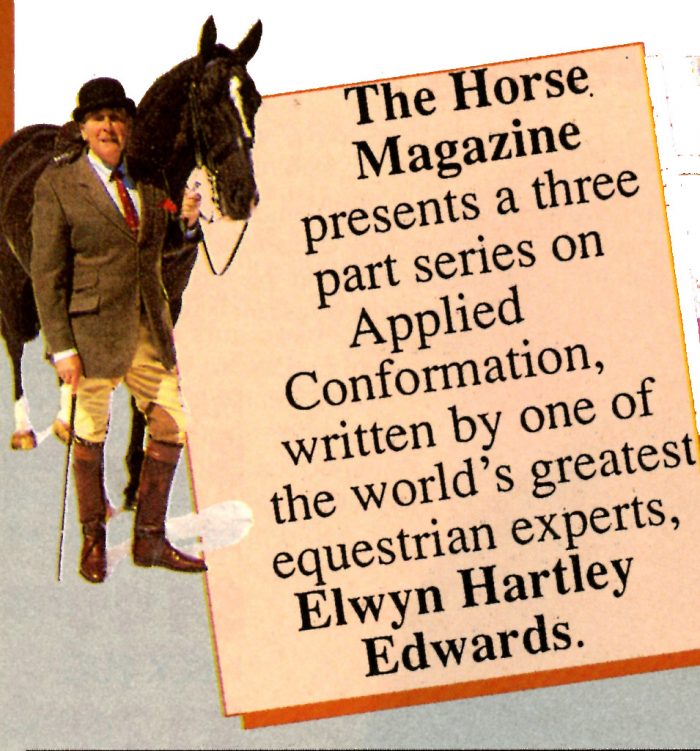
To the equine connoisseur, conformation is a source of constant fascination, and a subject of absorbing interest. Whether in the still expanding modern horse world it is generally understood, or its importance sufficiently appreciated is perhaps less certain, even though it remains fundamental to our use of the horse.
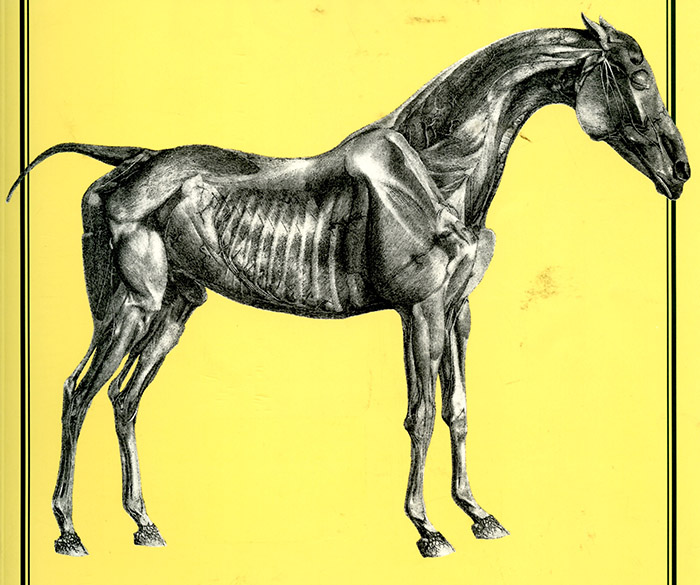
Even the most eminent judges of horses can, do, and will continue to disagree from time to time. However, the disagreement is, or ought to be, about nuances of conformation, not about fundamentals. Whether conformational judgements can ever be reduced to a scientific exactitude is unlikely, but well-established guidelines exist to provide a basic understanding of equine make and shape, and a sure foundation for those wanting to develop ‘an eye for a horse’. At the outset it is necessary to know what is meant by ‘conformation’, and after that to understand what is implicit in the variations which occur, in relation to their effect upon movement and the individual’s continuing physical efficiency.
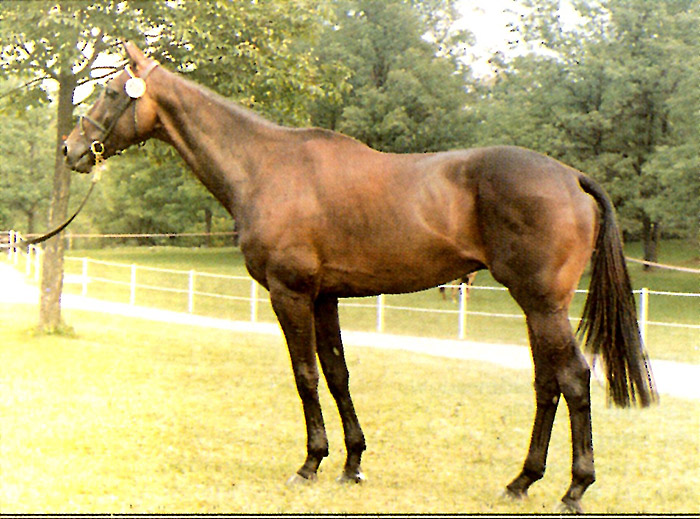
Looking at Messiah:
Elwyn Hartley-Edwards comments on the 1990 World Eventing Champion, Messiah –
This picture exemplifies the conformation conducive to speed and galloping ability. The frame is narrow, the proportions and the limbs long and the shoulder is at the maximum angle of slope. Note too, the high wither placed well to the rear. It is the point of attachment for the muscles supporting the forehand and it contributes significantly to the obliquity of the shoulder and the subsequent freedom and length of movement. Check the diagram of the ‘proportional horse’ against the proportions revealed in this example and take particular note of the position of the triangle formed by seat bone to point of hip; seat bone to stifle and stifle to point of hip – this is the placement best suited to speed.
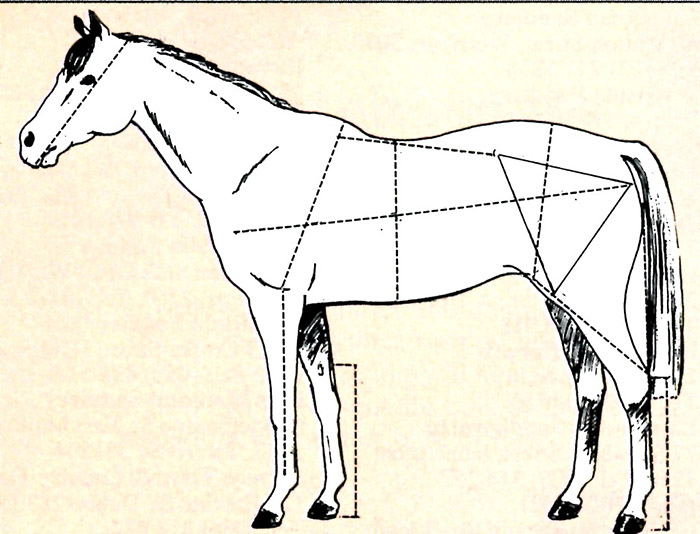
The Perfect Proportions
Essentially, we are talking about the skeletal frame (the foundations for the body mass) and its accompanying muscle structures in terms of the placement and symmetrical proportion of the individual parts. Exactly what constitutes ‘good’ conformation is a little more involved and poses the further question, ‘Good, for what?’
It depends, certainly, on a near-perfection of the overall form as a result of a corresponding perfection in the component parts and the excellence of their proportional relationships. A form, indeed, in which no one feature disturbs the overall symmetry by being insufficiently so. But even that is not enough. Conformation is only relevant when applied to the purpose for which the animal is required. ‘Good’ conformation, therefore, in addition to the overall proportions, etc, is that which copes most effectively with the intended activity.
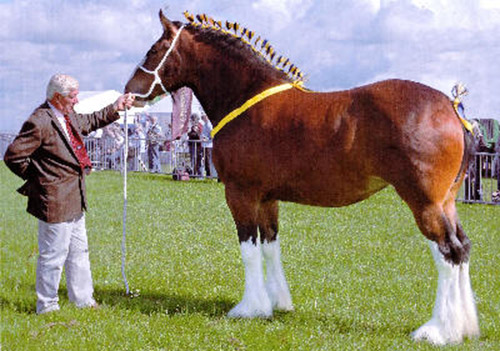
The conformation of the Shire horse,as extreme example, would be of no use at all on a racehorse but is suited ideally for slow, sustained work in heavy draught. Similarly, the racehorse is ill-equipped for the pushing (not pulling) action · which is the mechanism of draught, on account particularly of his light, oblique shoulder placement and his inappropriate build.
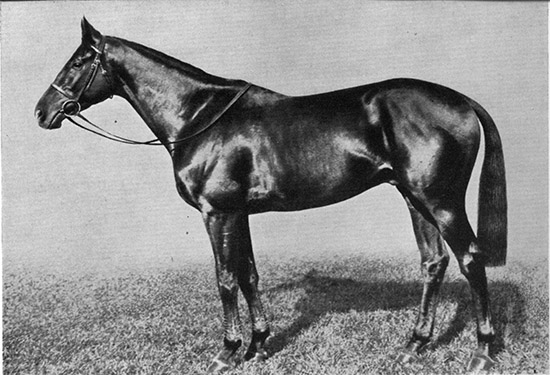
Indeed, between these two lies the great divide in conformation, the divide between strength at one end of the spectrum and speed at the other.
Animals in the former group are characterised by thick, short bones accompanied by corresponding muscular formations; the body tends to be longer and wider; the croup in heavy draught horses is often lower than the wither, in the interests of effective traction, and the placement of the shoulder (a critical element in both groups) is more upright, the blades being further apart than in the riding horse, whilst the humerus tends to be longer and as a result to place the foreleg more to the rear. In consequence, and in conjunction with the general build, the action in front is elevated and short, the formation of the shoulder being well-suited for ‘pushing’into the collar- a situation which contributes to great power in movement but not in speed….
The speed horse, conversely, is narrow and slender in build with long limbs and a body relatively short in proportion, the shoulder sloping from the junction of neck and wither to its point at an angle of some 60 degrees, with a short humerus bringing the leg further forward and thus allowing a long, low stride.
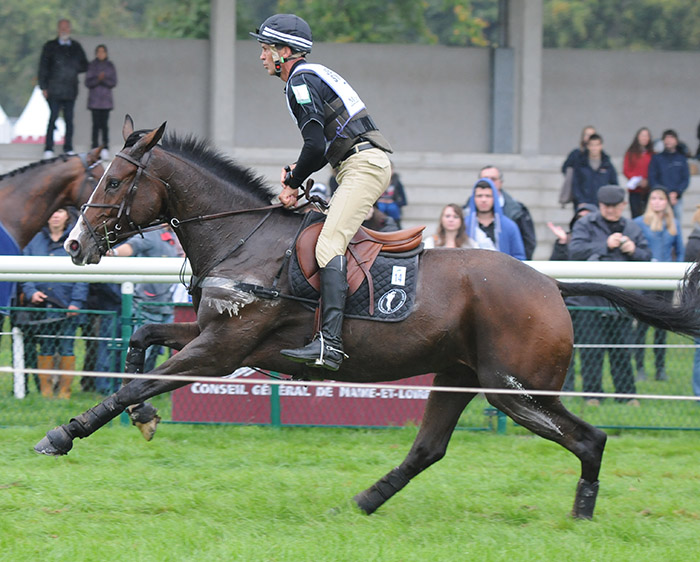
In between these two extremes is a multitude of horses inclined by their build more or less to speed or more or less to strength. It follows that according to the particular conformational mix they will be better or worse suited to one pursuit or another. The key to much that is involved in the study of conformation lies in the body proportion.
As a guide to that desirable in the riding horse we have Professor Wortley Axe’s carefully calculated measurements based on the work of the 19th century French veterinarians Bourgelat and Dulrousset. The first is concerned with measurements related to the length of the head and the length from the seat bone to the point of hip: the second with the assessment of the quarters and the placement of the hind limbs when viewed from the rear and the third is based on the triangle formed by seat bone, point of hip and stifle and shows the variations in hip placement and the desirable position of the cannon in relation to the seat bone when the horse is in movement. Reference will be made to these basic figures in following articles.
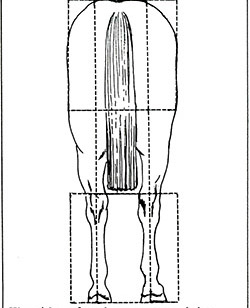
The sides of each square equal to length of the horse’s head.
The upright line passes through the centre of the hocks and fetlocks
Finally, in this introduction to conformation the importance of the proportionate, well-made form has to be considered. In the simplest terms the horse of good conformation should have a longer active working life than his less well-made counterpart. By virtue of his correct skeletal formation and proper proportions he has to be more mechanically efficient and has therefore a better chance of standing up to work under saddle without becoming unsound. Any deficiency in conformation is always a potential weakness and under stress it will be the first area to give way. A ‘twisted’ foreleg, one that is a little out of true with its partner will concentrate stresses and strains on one part of the joint rather than over the whole of the bearing surface.
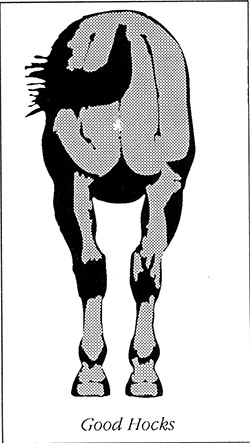
Ligaments may be subjected to uneven strains as a further result and thus suffer damage; whilst unequal wear in the foot mechanism may dispose the latter to disease. Weak, cow hocks resulting in uneven structural strain are conducive to the formation of curbs, spavins and thoroughpins. Feet with dropped soles are more easily damaged on rough going. Long backs and short ones can both produce problems, and so one could continue.
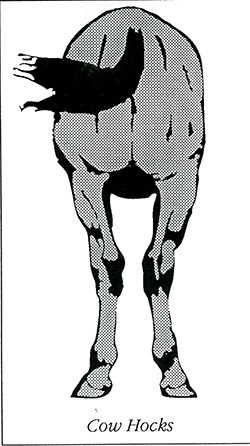
Good conformation should, also, be manifest in performance, action and balance. In fairness it has to be admitted that the first of this desirable trinity is not always or entirely concerned with conformation. In theory, of course, it should be, but there are other factors involved. The good performer is what he is because of his willingness to cooperate with the human requirement. It is matter of spirit as well as physique, but for all that conformation cannot be ignored.
Action is a result of conformation. Straight, well-formed limbs, properly placed, combine to produce a straight, free movement that is efficient and economical in terms of energy expenditure. Of course, it is possible by training to develop the movement, even to improve upon nature, but it is a fallacious and dangerous creed that advocates the consideration of action without a similar concern for conformation.
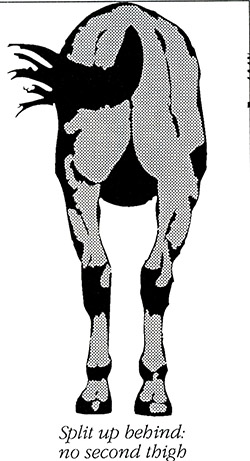
What is certain is that the well-made horse is a well-balanced one and, therefore, more likely to be possessed of an athletic quality. Balance facilitates schooling, is more comfortable to the rider, involves less risk of physical strain and is economical of effort. The horse’s temperament can also in some instances be related to conformation. Horses compelled to perform work outside their physical capacity, or forced to assume a carriage which by reason of some deficiency causes them discomfort will, understandably, become resentful and may then resort to all sorts of resistances.
Having taken a long, hard look at the overall structure of the horse, one needs to examine the individual components in some detail.
Next the head and neck are discussed
The head, rather like the human face, reveals a lot about the individual, but it should not be accorded too much emphasis in the overall judgement. After all, we do not ride the head and even the most beautiful one will never compensate for poor limbs or bad feet.
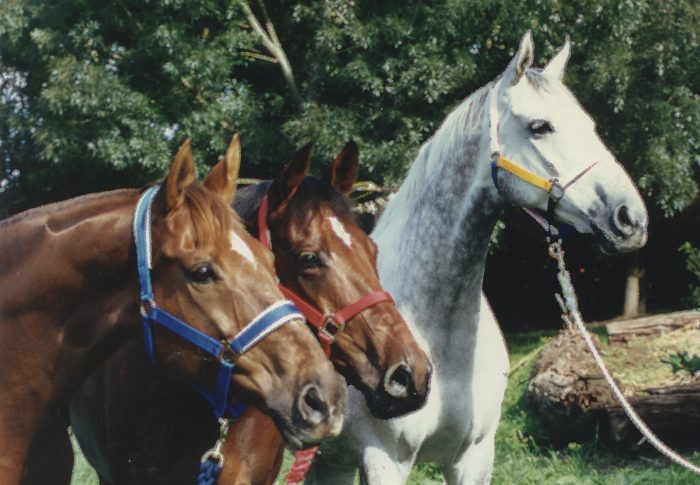
Well-bred horses have lean, finely chiselled heads, the skeletal formation being thinly covered with skin and the veins clearly visible. Common horses (nearer in ancestry to the heavy draught breeds) are characterised by a coarser appearance. The hair is thick and wiry, the skin covering thicker and the ears far less mobile (significant of a less responsive nature) than in the better-class horse. In the latter the profile is either straight or, if there are Arab connections, slightly concave. Common-bred horses usually exhibit a convex, ‘Roman nose’ profile which can also be seen in some weight carrying horses.
Everybody likes to see the big, generous eye, but take note of its placement on the head. In the riding horse the eyes need to be placed as much to the front as possible without the forehead being too broad since the horse has to be concerned with matters to his front and is expected to jump.
The slow-moving draught horse has his eyes placed more on the side of the head, a placement which improves lateral vision but is detrimental to the forward vision required of the riding horse.
Because horses breathe only through the nose, nostrils need to be large and wide enough to permit the maximum inhalation of air when horses are working at speed. Small, insensitive nostrils, incapable of being flared, are of no use to the riding horse. From a practical viewpoint it is desirable for the bone at the top of the head (the occipital crest) to be prominent, as it is the attachment point for the suspensory ligament of the head and neck. Hollows above the eyes (the supraorbital fossa) are usually an indication of age, but very fit horses, because of the absence of superfluous fat, may also exhibit slight hollows.
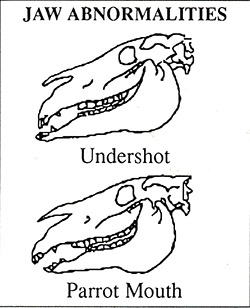
Finally there is the parrot mouth and its converse the over-shot lower jaw. Both cause bitting problems and possibly difficulty in grazing efficiently. However, what is of paramount importance is that the head must be proportionate to the neck which carries it, and to the body as a whole. Neck and head are rather like a pendulum with a forty pound weight attached to its end and together they serve as the balancing agent for the body mass. If the head and neck are raised, weight is shifted to the quarters; if they are stretched and lowered weight is transferred to the forehand. A heavy head of a size disproportionate to the neck results in the weight being carried over the forehand (and on the rider’s hand, too) and will prohibit any attempt to impose a balance based on the quarters.
A tiny head, which is rare, would also cause balancing problems. A relatively large head is acceptable enough in a heavyweight horse so long as it is accompanied by a comparatively short, strong neck. This is the sort of structure associated with strength, but also, of course, with somewhat slower paces. Conversely, lean heads set on fairly long, graceful necks are the attributes of speed. There can be more than one ideal, therefore, since what is suited to one purpose may not accord with the requirements of another. Certainly, the top side of the neck has to be longer than the lower.
A useful rule of thumb which can be taken as being generally adequate is as follows: measurement of neck from poll to highest point of wither = one and half times the length of head measured from the poll over the face to the lowest part of the upper lip. In most instances and for most purposes a light head with a strongly built neck of moderate length (a shade shorter rather than longer) is the most satisfactory and is held to be advantageous to the endurance capability. What is of especial importance is that the muscles of the neck should be in proportion to those of the foreleg, since the former motivate the latter by drawing it forward. So it follows that in the speed horse, equipped with a long forearm, the neck has to be of corresponding length. Conversely in the strength horse, like the draught breeds, the short, thick forearm has to be matched by a similarly proportioned neck. The manner in which the head is connected to the neck at one end (the setting-on of head and neck) and how it merges into the shoulder at the other will be considered in the next instalment.
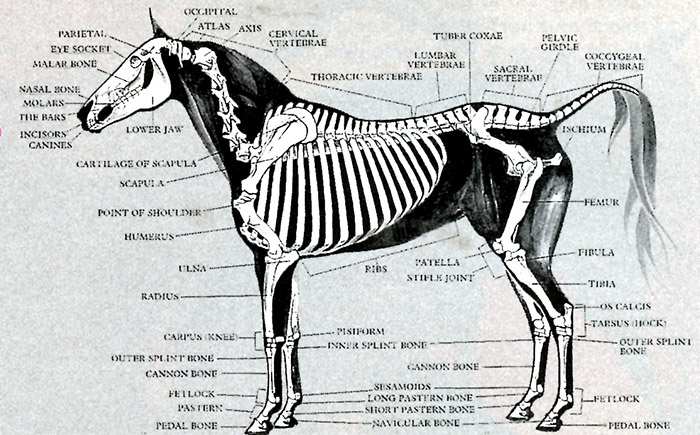
Elwyn Hartley Edwards was the doyen of equestrian authors. When he died at the age of 80, Captain Hartley Edwards had written 40 books on equestrian topics. His books sold more than a million copies in 12 languages. His most successful work, The Encyclopedia of the Horse sold nearly half a million. He was the editor of Riding magazine for 18 years and served on the British Horse Society Council and was the chairman of the BHS North-West Wales region for many years.
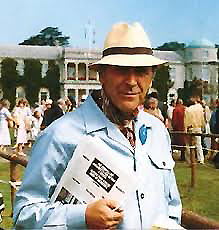
This article originally appeared in the May 1992 edition of THM
Breeding in 2018? Select a stallion with top European bloodlines, go to www.ihb.com.au
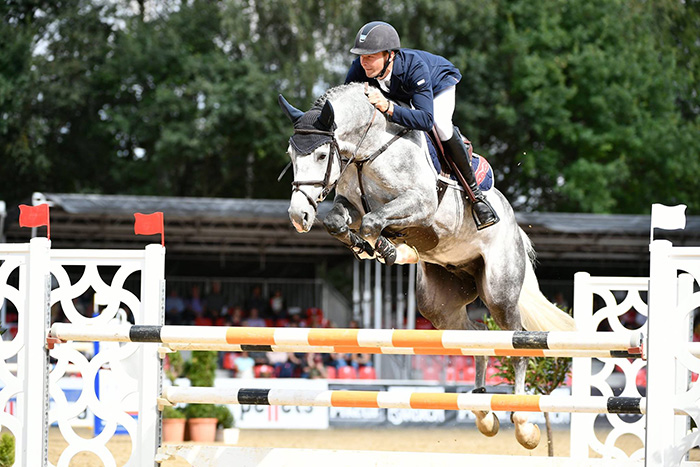
Diaron


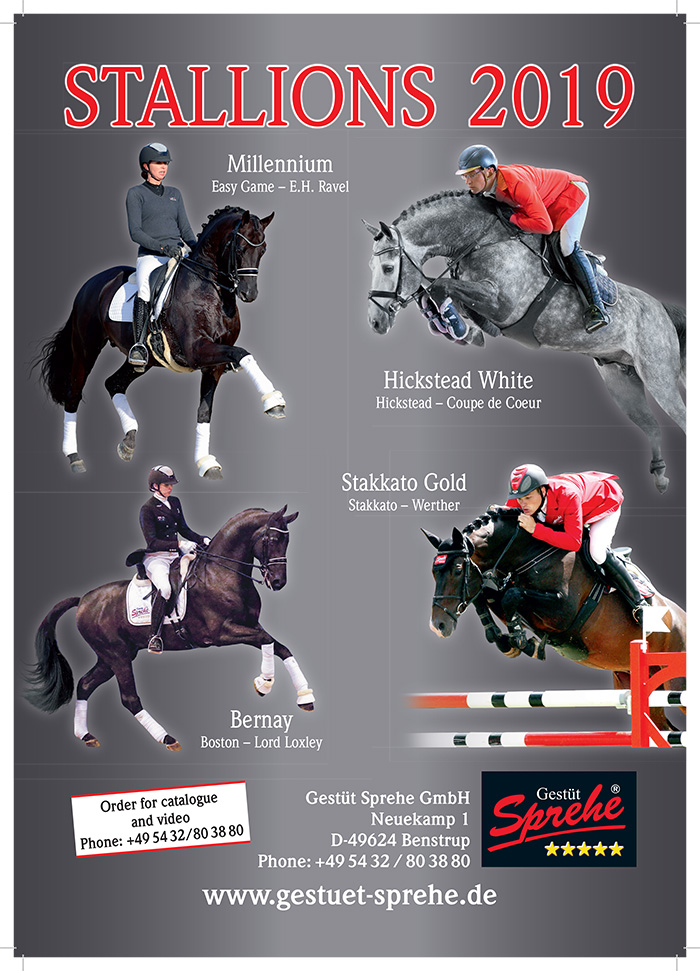

“Indeed, between these two lies the great divide in conformation, the divide between strength at one end of the spectrum and speed at the other.
Animals in the former group are characterised by thick, short bones accompanied by corresponding muscular formations; the body tends to be longer and wider; the croup in heavy draught horses is often lower than the wither, in the interests of effective traction, and the placement of the shoulder………”
I have something of a very different view here on body length.
After years and years of practical and theoretical training, buying horses and various courses with stud books in Europe. Being part of the evolving populations of horses literally from draught to sport horses I believe I have an eye for a riding horse. Making allowances for the discipline for which a horse is best suited. This is never fixed in my eye however but remains somewhat fluid to this day. Certainly in the past and indeed present having also added to the debate and taken into account the controversies surrounding the notion of the ideal build for breeding purposes, to function or discipline. Here pertinent to this discussion length of back has been such an issue. Stud books have been trying to decide and find the ideal and fix it into their populations of horses based on winning horses of the day. More in dressage than jumpers. This ideal has been something of a shape shifter. It has also been part of the history of the modern sports horse from draught, to light draught to carriage to sports horse and in various chronological orders. So too has the length of back been changing. The lighter carriage horses of Germany and Holland certainly always had longer backs and flatter croups compared to any heavy draught horses around they were extremely influential in the modern sports horse along with the draught and breeds like the thoroughbred.
Trying to fix the conformation now to discipline in the modern sports horse has resulted in breeding specifically for discipline and it hasn’t and continues not to be all plain sailing. Unwanted extremes are cropping up, throwing doubt on much present day wisdom of for example so absolutely separating dressage breeding from jumping etc. Do dressage horses need to be built like the for all intensive purposes completely crippled showing German Shepherd to function? For drive (schwung) and the all important elevated front? Just for one example? Is this too literal and not based in the reality of proper form over function.
These are discussions that can be extensive and heated. I would say my eye continues and in my opinion should continue to look for balance. For power where it needs to be, for ability where it needs to be and not for any extremes in type even though not everything needs to be absolute for function and that only appears when a horse moves.
Appraising a horse for me has never been at the expense of actually seeing the horse move of course and do its job or being able to demonstrate it’s potential no matter what it looks like. Long or short back to degrees. Im comfortable with my abilities. It’s second nature. That is, the first thing I do when I see a horse is without thinking, appraise it’s conformation, then watch it move. Mostly my eye is born out by the movement I see but just occasionally the horse compensates in some rather extraordinary way and Im surprised. My very early years doing this were based almost exclusively on the thoroughbred horse. I am still in the habit of standing at the runners circle and speed appraising each horse before I place a bet. Yes race horses differ hugely today from yesteryear, they also differ enormously according to the distance they are expected to run etc. So built for speed has more nuances. So too has the length of back been changing from long lined to closely coupled. Thoroughbreds taught me and continue to teach me a huge amount, certainly the modern sport horse is looking more and more like one in all it’s forms.
Only very recently however have I been drawn to the heavy horse. These horses are suddenly of immense fascination to me. Much of this has to do with the exposure of the types found in Eastern Europe and the former Soviet block over the recent years. Some truly exquisite looking horses, with a much greater sensitivity and what we would term “blood” than Im used to in the very heavy draught horse. Built like tanks, these are nonetheless “hot” draught animals barely fitting the description of cold bloods and come in various sizes. My disciplined riding horse eye has been getting much exercise that’s for sure! Comparing these and the old draughts of Western Europe I can confidently say they are and have always been, and consistently so, very much more close coupled than riding horses, indeed very often with croups higher than a mostly very flat wither. Though again balance is what is mostly looked for.
“Animals in the former group are characterised by thick, short bones accompanied by corresponding muscular formations; the body tends to be longer and wider; the croup in heavy draught horses is often lower than the wither, in the interests of effective traction, and the placement of the shoulder………”
The sliding scale from square to rectangle and back again is thus not quite so simply paired with strength. Certainly also if we look at old carriage horses like the Oldenburger and the Gelderlander with their very rectangular shape and the heavy draught with its close coupled square shape and their influences on the riding horse this doesn’t hold true. In fact there does seem to be a preponderance of rectangular shaped horses in sport horse breeding today, certainly if one looks at the hundreds and hundreds of horses at many of the auctions held by stud books on the continent. They are more on the leg, longer lined but in fact many are still simply too long in the back for our present ideals.
Iv’e hardly ever seen this on a heavy draught. They are as breeds though mostly except for a couple of exceptions also short legged thus perhaps only giving the impression of a longer back? However most are indeed very closely coupled on the continent.